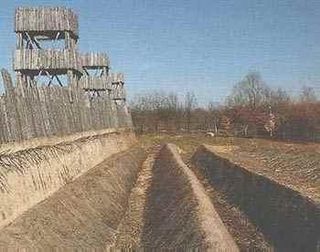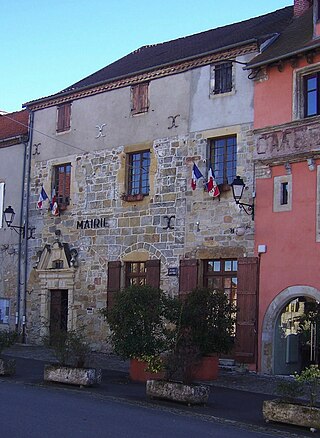
Vercingetorix was a Gallic king and chieftain of the Arverni tribe who united the Gauls in a failed revolt against Roman forces during the last phase of Julius Caesar's Gallic Wars. After surrendering to Caesar and spending almost six years in prison, he was executed in Rome.

This article concerns the period 59 BC – 50 BC.

Commentarii de Bello Gallico, also Bellum Gallicum, is Julius Caesar's firsthand account of the Gallic Wars, written as a third-person narrative. In it Caesar describes the battles and intrigues that took place in the nine years he spent fighting the Celtic and Germanic peoples in Gaul that opposed Roman conquest.

Year 58 BC was a year of the pre-Julian Roman calendar. At the time, it was known as the Year of the Consulship of Piso and Gabinius. The denomination 58 BC for this year has been used since the early medieval period, when the Anno Domini calendar era became the prevalent method in Europe for naming years.

The Gallic Wars were waged between 58 and 50 BC by the Roman general Julius Caesar against the peoples of Gaul. Gallic, Germanic, and Brittonic tribes fought to defend their homelands against an aggressive Roman campaign. The Wars culminated in the decisive Battle of Alesia in 52 BC, in which a complete Roman victory resulted in the expansion of the Roman Republic over the whole of Gaul. Though the collective Gallic armies were as strong as the Roman forces, the Gallic tribes' internal divisions eased victory for Caesar. Gallic chieftain Vercingetorix's attempt to unite the Gauls under a single banner came too late. Caesar portrayed the invasion as being a preemptive and defensive action, but historians agree that he fought the wars primarily to boost his political career and to pay off his debts. Still, Gaul was of significant military importance to the Romans. Native tribes in the region, both Gallic and Germanic, had attacked Rome several times. Conquering Gaul allowed Rome to secure the natural border of the river Rhine.

The Arverni were a Gallic people dwelling in the modern Auvergne region during the Iron Age and the Roman period. They were one of the most powerful tribes of ancient Gaul, contesting primacy over the region with the neighbouring Aedui.

The Battle of Alesia or siege of Alesia was the climactic military engagement of the Gallic Wars, fought around the Gallic oppidum of Alesia in modern France, a major centre of the Mandubii tribe. It was fought by the Roman army of Julius Caesar against a confederation of Gallic tribes united under the leadership of Vercingetorix of the Arverni. It was the last major engagement between Gauls and Romans, and is considered one of Caesar's greatest military achievements and a classic example of siege warfare and investment; the Roman army built dual lines of fortifications—an inner wall to keep the besieged Gauls in, and an outer wall to keep the Gallic relief force out. The Battle of Alesia marked the end of Gallic independence in the modern day territory of France and Belgium.
The Battle of Gergovia took place in 52 BC in Gaul at Gergovia, the chief oppidum of the Arverni. The battle was fought between a Roman Republican army, led by proconsul Julius Caesar, and Gallic forces led by Vercingetorix, who was also the Arverni chieftain. The Romans attempted to besiege Gergovia, but miscommunication ruined the Roman plan. The Gallic cavalry counterattacked the confused Romans and sent them to flight, winning the battle.

Bibracte, a Gallic oppidum, was the capital of the Aedui and one of the most important hillforts in Gaul. It was located near modern Autun in Burgundy, France. The material culture of the Aedui corresponded to the Late Iron Age La Tène culture.

Avaricum was an oppidum in ancient Gaul, near what is now the city of Bourges. Avaricum, situated in the lands of the Bituriges Cubi, was the largest and best-fortified town within their territory, situated on very fertile lands. The terrain favored the oppidum, as it was flanked by a river and marshland, with only a single narrow entrance. By the time of the Roman conquest in 52 BC the city according to Julius Caesar had a population of 40,000 people who were then almost all killed.

The Battle of the Axona was fought in 57 BC, between the Roman army of Gaius Julius Caesar and the Belgae. The Belgae, led by King Galba of the Suessiones, attacked, only to be repelled by Caesar. Fearing an ambush, the Romans delayed their pursuit. Caesar's Commentarii de Bello Gallico describes this battle at 2.7 - 2.11.

Alesia was the capital of the Mandubii, one of the Gallic tribes allied with the Aedui. The Celtic oppidum was conquered by Julius Caesar during the Gallic Wars and afterwards became a Gallo-Roman town. Modern understanding of its location was controversial for a long time; however, it is now thought to have been located on Mont-Auxois, near Alise-Sainte-Reine in Burgundy, France.
Gaius Caninius Rebilus was a Roman general and politician. As a reward for devoted service, Julius Caesar appointed him consul suffectus on the last day of December 45 BC.

Capdenac is a commune in the Lot department in south-western France.
Saint-Denis-lès-Martel is a commune in the Lot department in south-western France.

Vayrac is a commune in the Lot department in south-western France. The inhabitants of Vayrac are called the Vayracois.

Martel is a commune in the Lot department in southwestern France. It is a small medieval town in a region well known for its walnuts and truffles.

The Andecavi were a Gallic tribe dwelling in Aremorica during the Roman period.

Lucterius was a leader of the Cadurci, a Celtic people whose territory was located around Cahors in the modern French department of Lot. In the 50s BC, the Cadurci were under the rule of the Arverni, the civitas of Vercingetorix, under whom Lucterius served during the last stages of the Gallic Wars. In his memoirs, Julius Caesar calls him a man of unsurpassed boldness.
The siege of Uxellodunum was one of the last battles of the Gallic Wars. It took place in 51 BC at Uxellodunum. It was the last major military confrontation of the Gallic Wars and marked the pacification of Gaul under Roman rule. The battle resulted in a decisive Roman victory.


















